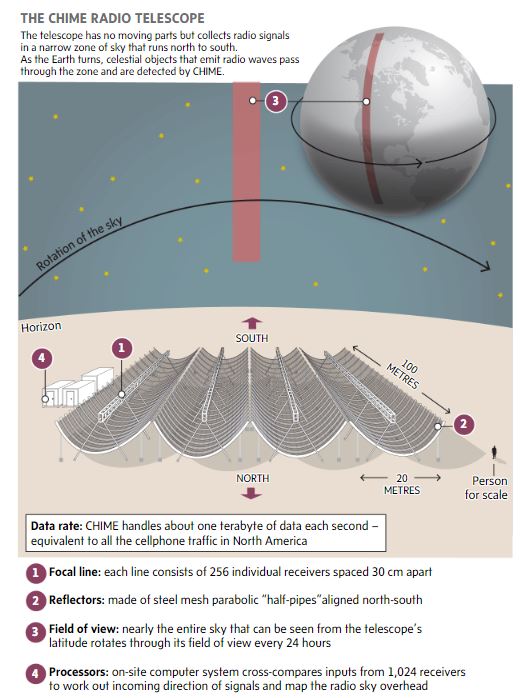Why in news?
Canadian Hydrogen Intensity Mapping Experiment (CHIME) has reported the sighting of a repeating fast radio burst from a distant galaxy.
What are Fast Radio Bursts?
- Fast Radio Bursts are brief (few millisecond) bursts of radio waves coming from far beyond our Milky Way galaxy.
- The phenomenon was first reported in 2007 and as of mid-2017, roughly two dozen have been reported and their origin is unknown.
- However, they are ubiquitous: current best estimates suggest these events are arriving at Earth roughly a thousand times per day over the entire sky.
- Of the known detected FRBs, one, FRB 121102, has been observed to repeat and has been shown to come from a small dwarf galaxy at redshift 0.2.
- Whether all FRBs repeat and/or are in dwarf galaxies is yet unknown.
What is CHIME?
- The CHIME Telescope is located at the Dominion Radio Astrophysical Observatory (DRAO), a national facility for astronomy operated by the National Research Council of Canada.
- The DRAO site is protected against man-made radio-frequency interference by municipal, provincial and federal regulation.
- The CHIME telescope's large collecting area, wide bandwidth and enormous field-of-view make it a superb detector of FRBs.
- The CHIME FRB event rate is predicted to be between 2 and 50 FRBs per day.
- So high an event rate promises major progress on this puzzling new astrophysical phenomenon.
- Bright CHIME-discovered FRBs will be found in real time and reported immediately to the worldwide astrophysical community for multi-wavelength follow up.

What are the recent reporting of the CHIME?
- A mysterious radio signal emanating from a galaxy far, far away has been detected by CHIME.
- The discovery is significant because it’s only the second time ever a repeating signal has been observed by scientists.
- In addition to the second repeater, the researchers were able to shed new light on FRBs because they detected them at a much lower frequency than previously recorded finds.
- The radio bursts were observed by CHIME at frequencies between 400 megahertz (MHz) and 800 MHz.
- The majority of previously detected FRBs were found at frequencies near 1400 MHz.
Source: Indian Express